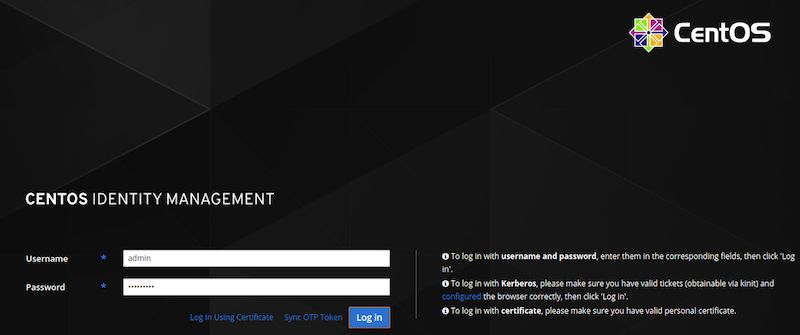
In this tutorial, we will show you how to install FreeIPA on CentOS 8. For those of you who didn’t know, FreeIPA is an open-source identity management system for Linux/Unix environments that provides centralized account management and authentication, like Microsoft Active Directory or LDAP.
This article assumes you have at least basic knowledge of Linux, know how to use the shell, and most importantly, you host your site on your own VPS. The installation is quite simple and assumes you are running in the root account, if not you may need to add ‘sudo‘ to the commands to get root privileges. I will show you the step-by-step installation of FreeIPA on CentOS 8.
Prerequisites
- A server running one of the following operating systems: CentOS 8.
- It’s recommended that you use a fresh OS install to prevent any potential issues.
- SSH access to the server (or just open Terminal if you’re on a desktop).
- A
non-root sudo useror access to theroot user. We recommend acting as anon-root sudo user, however, as you can harm your system if you’re not careful when acting as the root.
Install FreeIPA on CentOS 8
Step 1. First, let’s start by ensuring your system is up-to-date.
sudo dnf install epel-release sudo dnf update
Step 2. Installing FreeIPA on CentOS 8.
Now we setup Hostname, you can set up it with the following command:
hostnamectl set-hostname freeipa.idroot.us echo "192.168.77.1 freeipa.idroot.local ipa" >> /etc/hosts
FreeIPA packages are provided by the Identity Management system module of CentOS 8 AppStream repos. Therefore, you need to enable the idm:DL1 stream by running the command:
sudo dnf module enable idm:DL1
Next, sync the repository with the following command:
sudo dnf distro-sync
Finally, install FreeIPA on CentOS 8 system using the following command:
sudo dnf install ipa-server ipa-server-dns
Step 3. Configure FreeIPA.
You will need to set up the FreeIPA server. we can set up it with the following command:
ipa-server-install --setup-dns
Here is how this configuration will look by running the previous command:
[root@idroot.us ~]# ipa-server-install --setup-dns The log file for this installation can be found in /var/log/ipaserver-install.log ============================================================================== This program will set up the IPA Server. This includes: * Configure a stand-alone CA (dogtag) for certificate management * Configure the Network Time Daemon (ntpd) * Create and configure an instance of Directory Server * Create and configure a Kerberos Key Distribution Center (KDC) * Configure Apache (httpd) * Configure DNS (bind) To accept the default shown in brackets, press the Enter key. Enter the fully qualified domain name of the computer on which you're setting up server software. Using the form <hostname>.<domainname> Example: master.example.com. Server host name [freeipa.idroot.us]: [ENTER] Warning: skipping DNS resolution of host freeipa.idroot.local The domain name has been determined based on the host name. Please confirm the domain name [idroot.us]:[ENTER] The kerberos protocol requires a Realm name to be defined. This is typically the domain name converted to uppercase. Please provide a realm name [IDROOT.US]: [ENTER] Certain directory server operations require an administrative user. This user is referred to as the Directory Manager and has full access to the Directory for system management tasks and will be added to the instance of directory server created for IPA. The password must be at least 8 characters long. Directory Manager password: [ENTER PASSWORD] Password (confirm): [ENTER PASSWORD] . . . . .
After the FreeIPA installation, authenticate to the Kerberos realm to ensure that the administrator is configured correctly:
kinit admin
You can as well list Kerberos tickets using the klist command:
klist
Step 4. Configure Firewall.
You will need to allow some ports used by FreeIPA. You can allow them with the following command:
sudo firewall-cmd --add-service={http,https,dns,ntp,freeipa-ldap,freeipa-ldaps} --permanent
sudo firewall-cmd --reload
Next, you will also need to disable the SELinux in your system:
sudo setenforce 0 sudo sed -i 's/^SELINUX=.*/SELINUX=permissive/g' /etc/selinux/config
Step 5. Accessing the FreeIPA Web interface.
FreeIPA will be available on HTTP port 80 by default. Open your favorite browser and navigate to https://freeipa.idroot.us/ and complete the required steps to finish the installation. Ignore the private SSL warning and proceed to the FreeIPA server login page. Use the username, admin, and admin password provided during the installation setup.

Congratulations! You have successfully installed FreeIPA. Thanks for using this tutorial to install the FreeIPA on CentOS 8 system. For additional help or useful information, we recommend you to check the official FreeIPA website.